

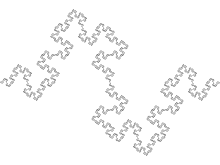
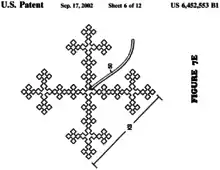
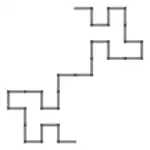
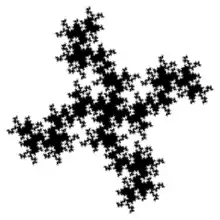
The Minkowski sausage[3] or Minkowski curve is a fractal first proposed by and named for Hermann Minkowski as well as its casual resemblance to a sausage or sausage links. The initiator is a line segment and the generator is a broken line of eight parts one fourth the length.[4]
The Sausage has a Hausdorff dimension of .[lower-alpha 1] It is therefore often chosen when studying the physical properties of non-integer fractal objects. It is strictly self-similar.[4] It never intersects itself. It is continuous everywhere, but differentiable nowhere. It is not rectifiable. It has a Lebesgue measure of 0. The type 1 curve has a dimension of ln 5/ln 3 ≈ 1.46.[lower-alpha 2]
Multiple Minkowski Sausages may be arranged in a four sided polygon or square to create a quadratic Koch island or Minkowski island/[snow]flake:
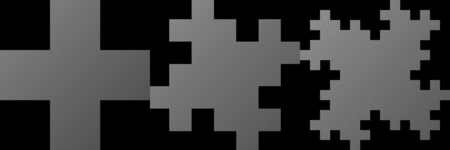
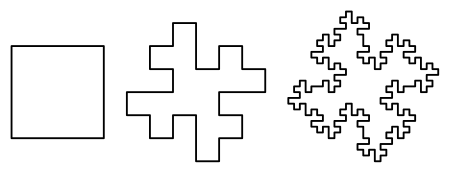


See also
Notes
References
- ↑ Cohen, Nathan (Summer 1995). "Fractal antennas Part 1". Communication Quarterly: 7–23.
- ↑ Ghosh, Basudeb; Sinha, Sachendra N.; and Kartikeyan, M. V. (2014). Fractal Apertures in Waveguides, Conducting Screens and Cavities: Analysis and Design, p. 88. Volume 187 of Springer Series in Optical Sciences. ISBN 9783319065359.
- ↑ Lauwerier, Hans (1991). Fractals: Endlessly Repeated Geometrical Figures. Translated by Gill-Hoffstädt, Sophia. Princeton University Press. p. 37. ISBN 0-691-02445-6.
The so-called Minkowski sausage. Mandelbrot gave it this name to honor the friend and colleague of Einstein who died so untimely (1864-1909).
- 1 2 Addison, Paul (1997). Fractals and Chaos: An illustrated course, p. 19. CRC Press. ISBN 0849384435.
- 1 2 Weisstein, Eric W. (1999). "Minkowski Sausage", archive.lib.msu.edu. Accessed: 21 September 2019.
- 1 2 Pamfilos, Paris. "Minkowski Sausage", user.math.uoc.gr/~pamfilos/. Accessed: 21 September 2019.
- 1 2 Weisstein, Eric W. "Minkowski Sausage". MathWorld. Retrieved 22 September 2019.
- ↑ Mandelbrot, B. B. (1983). The Fractal Geometry of Nature, p. 48. New York: W. H. Freeman. ISBN 9780716711865. Cited in Weisstein MathWorld.
- ↑ Schmidt, Jack (2011). "The Koch snowflake worksheet II", p. 3, UK MA111 Spring 2011, ms.uky.edu. Accessed: 22 September 2019.
External links
- "Square Koch Fractal Curves". Wolfram Demonstrations Project. Retrieved 23 September 2019.